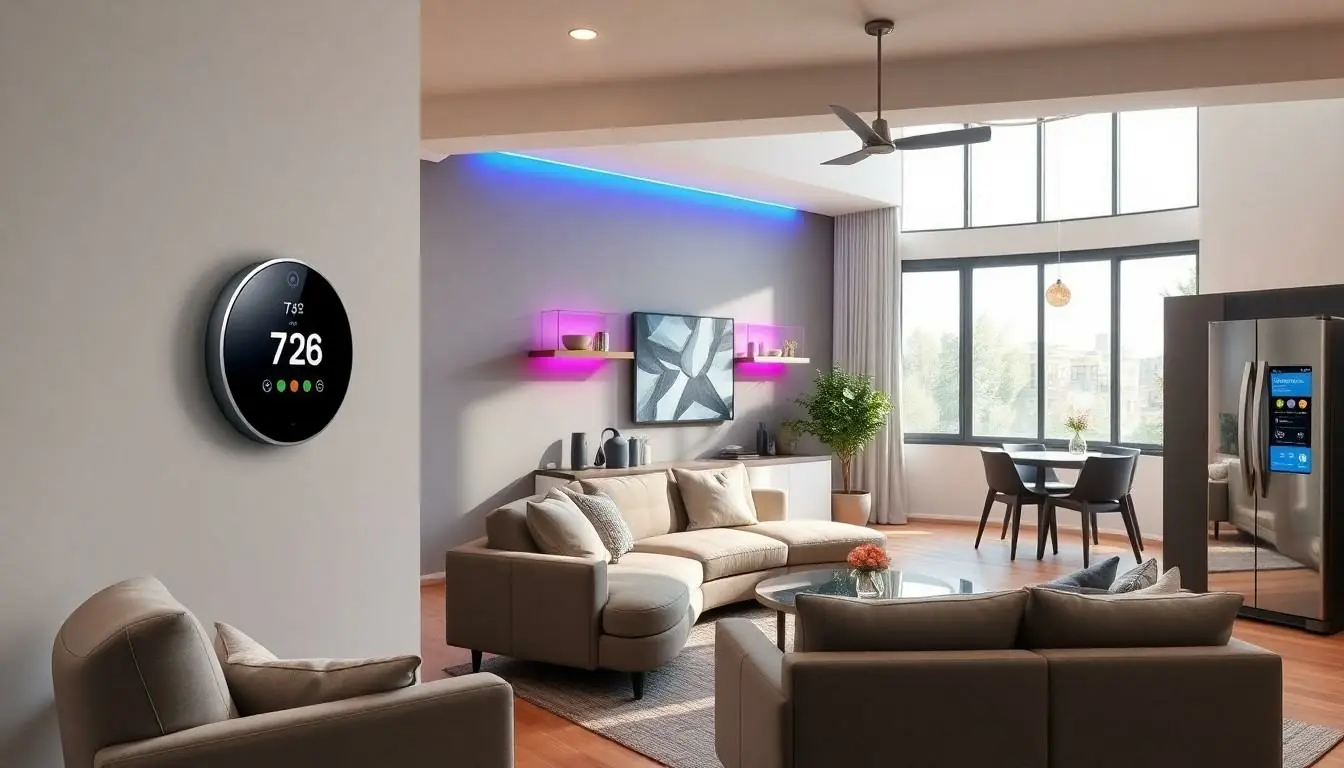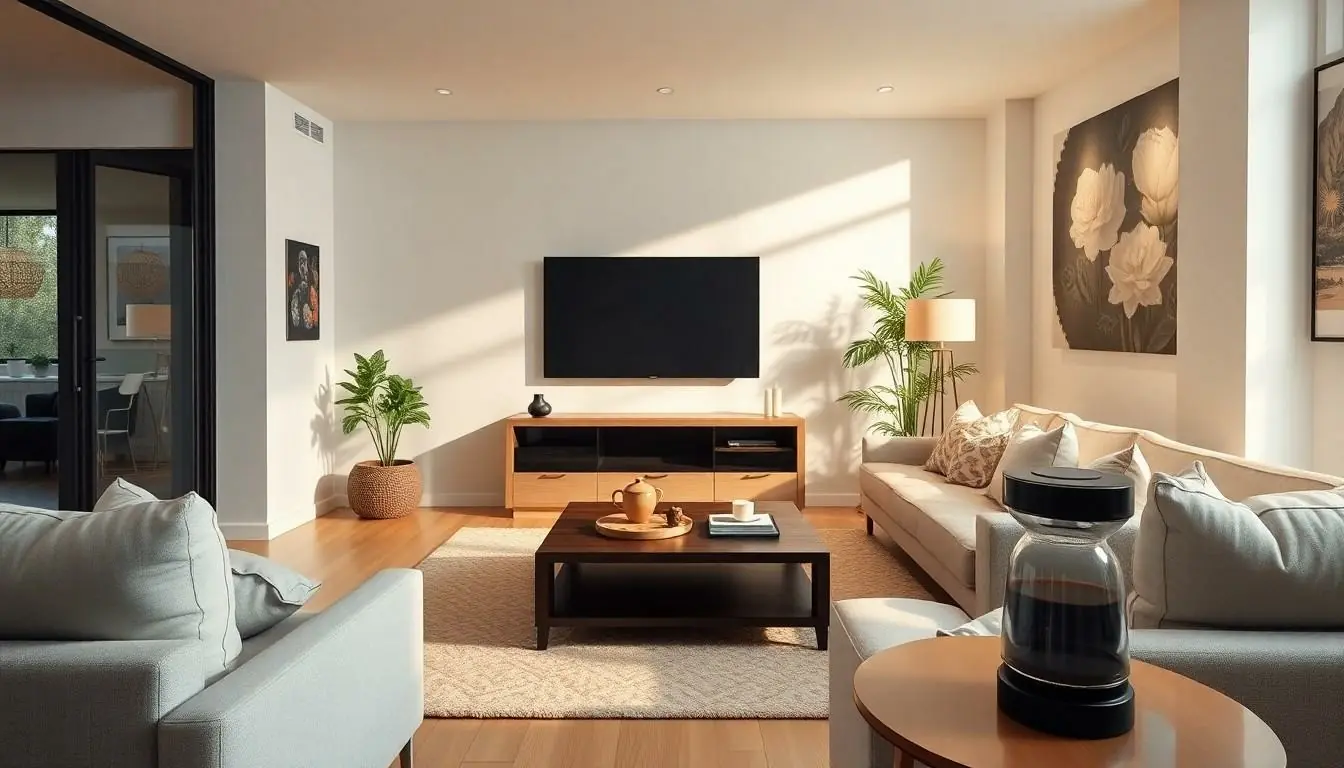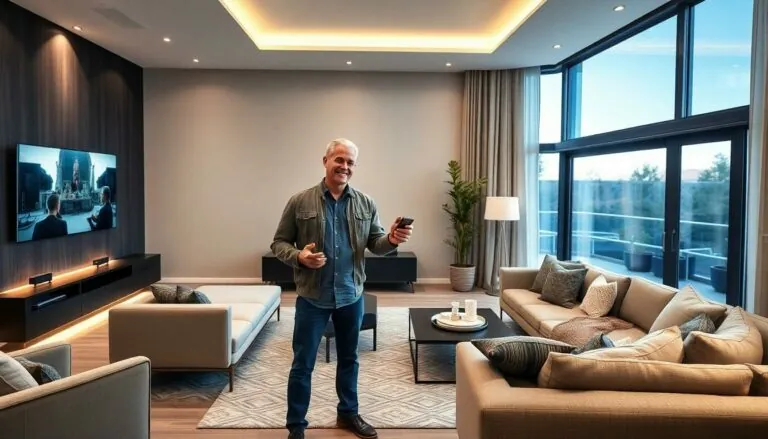Imagine a home that knows you better than your best friend—where the lights dim just as you sink into the couch and the coffee brews itself on a sleepy Monday morning. Smart home design isn’t just a trend; it’s the future knocking at your door, and it’s got some seriously cool gadgets in tow.
Table of Contents
ToggleOverview of Smart Home Design
Smart home design integrates advanced technology to enhance everyday living. This approach creates a responsive environment that adapts to the needs of its occupants.
Definition of Smart Home Design
Smart home design refers to the incorporation of automation and control systems in residential spaces. These systems connect various devices such as lights, heating units, and security cameras to a centralized network. Users manage these devices through smartphones, tablets, or voice commands. Intelligent algorithms streamline operations, enabling homes to learn preferences and habits. Such technology enhances convenience and efficiency.
Importance of Smart Home Design
Smart home design offers numerous benefits for modern living. Enhanced energy efficiency reduces utility costs and environmental impact. Improved security systems provide real-time monitoring and alerts, increasing safety. Comfort levels rise with automated controls for lighting and temperature. Convenient access to home systems simplifies daily tasks. Smart technology also encourages a seamless integration of lifestyle and home management, promoting well-being.
Key Components of Smart Home Design

Smart home design incorporates various essential components that enhance functionality and convenience. Two significant elements include smart devices and home automation systems.
Smart Devices and Appliances
Smart devices and appliances are integral to the smart home experience. Examples include smart thermostats, smart lighting, and smart refrigerators. Each device connects to a central network, allowing for seamless control. Users can adjust settings remotely, enabling efficiency and energy savings. Notably, these devices gather data over time to learn individual preferences. This intelligence allows them to optimize energy usage and enhance comfort.
Home Automation Systems
Home automation systems serve as the backbone of smart home design. These systems connect multiple devices, enabling centralized control through apps or voice commands. Examples of automation include scheduling lights to turn on at specific times or adjusting the thermostat based on occupancy. Notably, these systems enhance security by integrating smart cameras and alarms. Home automation simplifies everyday tasks, allowing users to focus on what matters most. Through automation, homes respond autonomously, creating an efficient living environment.
Benefits of Smart Home Design
Smart home design provides multiple advantages that enhance living experiences through automation and connectivity. Here are some key benefits.
Energy Efficiency
Energy efficiency ranks high among the advantages of smart home design. Smart thermostats automatically adjust heating and cooling based on occupancy, leading to significant savings on energy bills. In addition, smart lighting adapts to ambient light levels, reducing electricity usage when natural light is sufficient. Homeowners can monitor energy consumption through user-friendly apps, making it easier to identify and rectify inefficiencies. According to the U.S. Department of Energy, homes that implement smart technology may see energy reductions of up to 30%. Homeowners enjoy a more sustainable lifestyle while reducing environmental impact through these energy-saving features.
Enhanced Security
Enhanced security stands out as another crucial benefit of smart home design. Smart security systems, including cameras and smart locks, allow homeowners to monitor their properties remotely. Real-time alerts notify users of potential intrusions, enabling prompt action. Integration of sensors can trigger alarms or notify authorities when suspicious activity occurs. Data from the Pew Research Center indicates that 81% of adults feel safer with smart home security systems. Peace of mind transforms daily living by ensuring a secure environment, making smart homes a desirable feature for modern homeowners.
Improved Convenience
Improved convenience significantly influences smart home design advantages. Voice-activated assistants simplify daily tasks, from adjusting the thermostat to playing music hands-free. Homeowners streamline routines by scheduling appliances and lighting to operate at specific times. Multi-device integration allows users to control various functions from a single app, eliminating the need for multiple remotes. A survey by Statista found that over 70% of smart home device owners report increased comfort in their lives. With these conveniences available, modern living adapts around individual needs, enhancing the overall home experience.
Challenges in Smart Home Design
Smart home design presents various challenges that users and designers face when implementing innovative technology solutions. Understanding these issues becomes critical to creating an efficient and user-friendly environment.
Compatibility Issues
Compatibility issues arise frequently in smart home design. Different manufacturers often produce devices that don’t communicate effectively, leading to frustration for users. For instance, a smart thermostat may not integrate seamlessly with an existing security system, limiting functionality. Ensuring that devices operate on common protocols like Zigbee or Z-Wave can mitigate these challenges. Choosing products from the same ecosystem also enhances interoperability. Researching compatibility before purchasing devices cuts down on potential issues, streamlining the installation process.
Privacy Concerns
Privacy concerns represent a significant challenge in smart home design. Smart devices collect vast amounts of personal data, including user habits and preferences. This data can become vulnerable to hacking or misuse without proper security measures. Homeowners want assurance their information remains confidential. Integrating robust encryption protocols and regularly updating device firmware helps safeguard sensitive data. Highlighting privacy policies from manufacturers also informs users about data handling practices. Educating homeowners about the importance of security features empowers them to make more informed decisions.
Cost Considerations
Cost considerations play a vital role in the success of smart home design. High-quality smart devices often come with a hefty price tag that may deter potential buyers. Budget-friendly alternatives exist but may lack essential features or reliability. Evaluating the long-term savings generated from energy-efficient devices often justifies the initial investment. Creating a budget before starting the design process ensures a balanced approach to purchasing. Incorporating installations gradually allows homeowners to manage costs without overwhelming their finances.
Future Trends in Smart Home Design
Smart home design continues to evolve rapidly, highlighting key trends that shape its future. Innovations in technology play a significant role in transforming how homes operate and respond.
Integration of AI and Machine Learning
AI and machine learning enhance smart home systems by enabling devices to learn user preferences. Innovations like adaptive lighting and temperature adjustments occur automatically, based on behavioral patterns. Smart assistants evolve through continuous learning, improving interactions and voice recognition. Predictive analytics can anticipate household needs, increasing efficiency. With each interaction, devices become more intuitive, providing tailored experiences for residents.
Increased Focus on Sustainability
Sustainability has become a priority in smart home design, driven by energy-efficient technologies. Smart appliances reduce energy consumption, benefiting both the environment and homeowners’ wallets. Connected systems encourage conservation by monitoring usage patterns and providing real-time feedback. Additionally, innovations in renewable energy integration allow homes to harness solar or wind power. Green building materials and energy management systems support eco-friendly living, reinforcing the commitment to sustainability in residential spaces.
Smart home design is transforming the way people interact with their living spaces. By integrating advanced technology and automation, homes are becoming more responsive and efficient. This evolution not only enhances comfort and security but also promotes energy savings and sustainability.
As technology continues to advance, the future of smart home design looks promising. Innovations in AI and machine learning will further refine user experiences, making homes even more intuitive. While challenges like compatibility and privacy concerns exist, careful planning and informed choices can help navigate these issues.
Embracing smart home design is not just about convenience; it’s about creating a lifestyle that aligns with modern needs and values. The journey towards a smarter home is just beginning, and the possibilities are endless.





